الأسواق
عند تصميم تدخل إنساني وتحديد ما إذا كان سيتم استخدام المساعدات النقدية والقسائم، يجب أن يكون تحليل السوق جزءًا من تحليل الاستجابة الشامل. وثبت أن دعم الأسواق للعمل بشكل جيد يؤدي إلى تعافي أسرع وزيادة المرونة في المناطق المتضررة من الكوارث.
واستثمرت العديد من المنظمات في تطوير أدوات لدعم تحليل السوق وتفكر في البرمجة القائمة على السوق بشكل أكثر شمولية. يشمل ذلك التدخلات التي تستخدم السوق (مثل التحويلات النقدية إلى السكان المتضررين)، بالإضافة إلى التدخلات التي تدعم الأسواق بشكل مباشر (مثل المنح المشروطة للمتداولين لإعادة تشغيل أسواقهم).
Related initiatives
Featured content

Introduction to Market Analysis
دورة تدريبية
This 30 minute online course provides an introduction to the analysis of markets in emergency contexts, with input from some of the world’s leading thinkers on the topic.

A Practical Guide to Market Analysis in Humanitarian response
دورة تدريبية
A three to four hour online course designed to provide future humanitarian market assessment team members with a solid understanding of theory and steps of market assessments so that they can join assessment teams prepared with a basic understanding of what they will be doing and why.
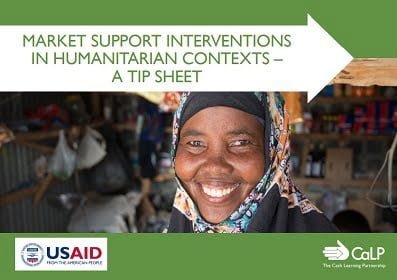
Market Support Interventions in Humanitarian Contexts – a Tip Sheet
Guidelines and Tools
This tip sheet defines what market support programming in humanitarian contexts is, and what it can look like in practice. It enables humanitarian practitioners to systematically consider market support interventions alongside other programme activities. The scope includes support interventions focusing on supply/availability and on demand/access. The tip sheet is based on secondary data...
Latest

Public Health Agencies and Cash Transfer Programmes: Making the case for greater involvement
Policy paper
This report examines the case for greater involvement by public health agencies in cash transfer schemes, a form of welfare assistance. It seeks to identify opportunities, obstacles and actions that might support greater involvement. The issue arises because cash transfer schemes are an increasingly...

An Evaluation of Save the Children’s Cash Transfer Project in Aweil East County, Northern Bahr el Ghazal State, South Sudan
Report
Since April 2009, Save the Children have been implementing an ECHO-funded cash transfer project in Baac Payam, Aweil East County. The specific objective of this project has been to improve dietary diversity and nutritional outcomes among the targeted households that inhabit a part of Sudan which has some...
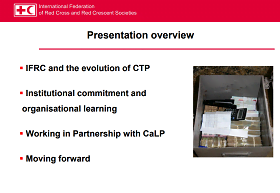
IFRC and the evolution of CTP
Presentation
An IFRC presentation covering the following topics: IFRC and the evolution of CTP Institutional commitment and organisational learning Working in Partnership with the CALP Network Moving forward
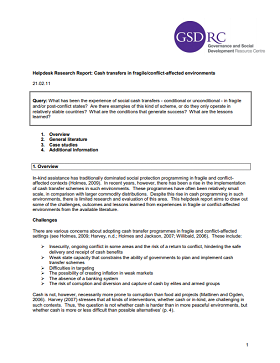
Helpdesk Research Report: Cash Transfers in Fragile/Conflict-Affected Environments
Report
In-kind assistance has traditionally dominated social protection programming in fragile and conflict-affected contexts (Holmes, 2009). In recent years, however, there has been a rise in the implementation of cash transfer schemes in such environments. These programmes have often been relatively small...

Emergency Livelihood Recovery Intervention (ELRI): Fafi District – Garissa County – North Eastern Kenya
Report
The Emergency Livelihood Recovery Intervention (ELRI) was implemented by Horn Relief with funding from OFDA. The Emergency Livelihood Recovery Intervention (ELRI) took place between January 2010 and April 2011; it was designed to address the immediate food security needs of the drought-stricken population...
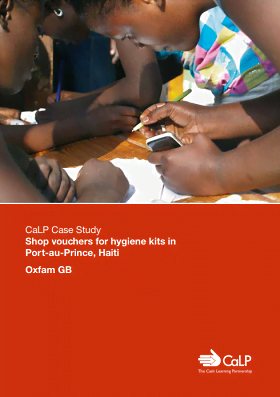
Shop vouchers for hygiene kits in Port-au-Prince, Haiti (the CALP Network Case Study)
Report
In the aftermath of the 2010 Haiti earthquake, Oxfam’s Public Health Promotion team used a voucher programme to provide beneficiaries with essential hygiene items through local shops. The voucher system was chosen so that beneficiaries could access hygiene items in a normal and dignified way, and in...

Protection
Guidelines and Tools
Protection mainstreaming is a practical, efficient and effective means to maximise the protective impact of aid programming. Through incorporating protection principles into aid design and delivery, humanitarian actors can:
Promote the human rights of affected populations
Enhance affected populations’...
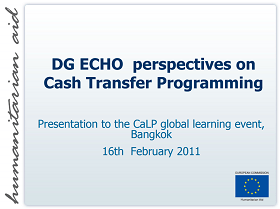
DG ECHO perspectives on Cash Transfer Programming
Presentation
A presentation accompanying the CALP Network global learning event, Bangkok 16th February 2011, covering the following topics: DG ECHO position on the use of Cash &Vouchers (C&V) Trends in funding C&V projects Using C&V at scale: the case of Haiti Capacity building priorities
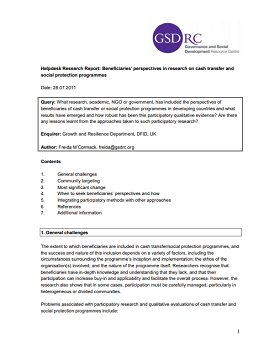
Helpdesk Research Report: Beneficiaries’ perspectives in research on cash transfer and social protection programmes
Report
Query: What research, academic, NGO or government, has included the perspectives of beneficiaries of cash transfer or social protection programmes in developing countries and what results have emerged and how robust has been this participatory qualitative evidence? Are there any lessons learnt from the...
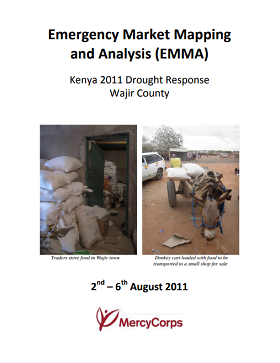
EMMA – Wajir, Kenya
Report
Mercy Corps conducted an adapted Emergency Market Mapping and Analysis (EMMA) assessment in Wajir County of Kenya from 2-6 August 2011. The assessment was organized as a response to the hunger crisis resulting from the worst drought in the region in the last 60 years. The EMMA methodology was adapted...
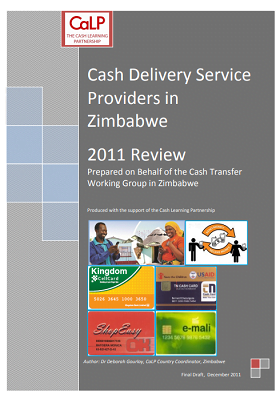
Cash Delivery Service Providers in Zimbabwe
Report
Over the past few years Zimbabwe has witnessed a significant increase in the use of cash transfers within policies and programs providing humanitarian aid. This has resulted is an increasing desire on the part of humanitarian agencies to partner with private sector financial service providers in the...
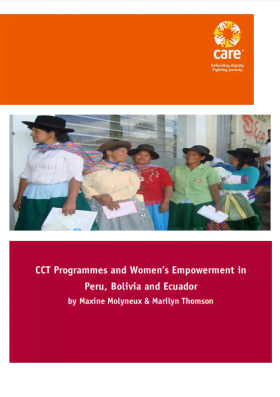
CCT Programmes and Women’s Empowerment in Peru, Bolivia and Ecuador
Report
Latin America’s efforts to alleviate poverty have resulted in reducing poverty in twelve countries, most strikingly in Mexico and Brazil. The adoption of Cash Transfer programmes in much of the region is credited with helping to bring this reduction about. These programmes are widely promoted as a cost...

Results of the Market Information and Food Insecurity Response Analysis (MIFIRA) framework conducted in two locations in Kenya
Case Study
This research paper shows the results of the MIFIRA framework which was applied through a Catholic Relief Services programme in one urban and one rural location in Kenya. The difference between urban and rural food security is explained and then the findings of the two case studies are described in...
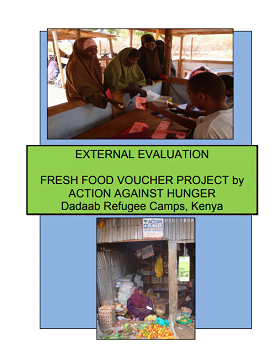
External Evaluation: Fresh Food Voucher Project by Action Against Hunger in Dadaab Refugee Camps, Kenya
Report
The town of Dadaab in North Eastern Kenya is home to three refugee camps: Hagadera, Dagahaley and Ifo hosting over 240,000 people. The camps were established in mid-1992 after the closure of the Liboi camp, which was too close to the Kenya/Somali border to ensure adequate security. Continued insecurity in...
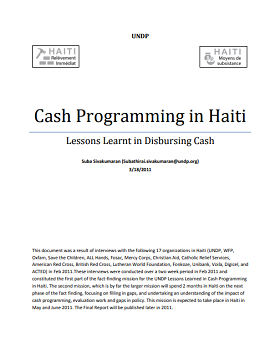
Cash Programming in Haiti – Lessons Learned in Disbursing Cash
Report
The following report is the result of an initial 2 week mission to Haiti to investigate cash programming (including cash for work) amongst 17 organizations. It is not intended as an exhaustive review of 17 organizations’ practices, but attempts to look at what were some of the critical stages in cash...
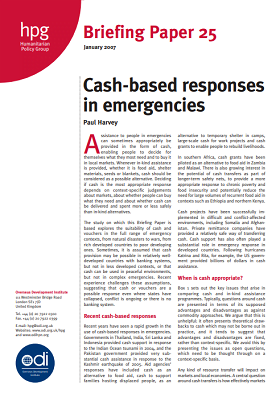
Cash-based Responses in Emergencies
Report
This short HPG briefing paper looks at the suitability of cash based responses in a range of emergency situations. It gives a rapid overview of recent cash based responses and examines the key issues around comparing cash and in-kind programmes. It briefly looks at the impact of cash, the issues of...

Richer but Resented: What do cash transfers do to social relations and does it matter?
Report
This paper looks at how social protection cash transfers are evaluated primarily in terms of poverty reduction or human capital, with their impact on social relations being under-examined. The authors examine case studies from Kenya, Malawi and Zimbabwe, and argue that the impact of cash transfers on...

Case Study of Cash Transfer to Traders during the Pakistan Earthquake of 2005
Case Study
This case study examines Oxfam’s innovative programme to provide cash/vouchers to local traders to re-establish their businesses and re-initiate an economic stimulus in order to help vulnerable people purchase, or put on credit, food and non-food items throughout the upcoming winter. The paper looks at...
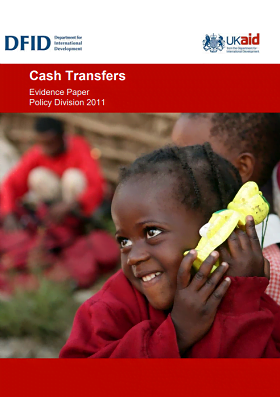
Cash transfers: Evidence paper
Report
This DFID evidence paper provides a synthesis of current global evidence on the impact of cash transfers in developing countries in achieving a range of social and economic policy objectives. It examines design and implementation choices for tailoring programmes to particular objectives, notably social...
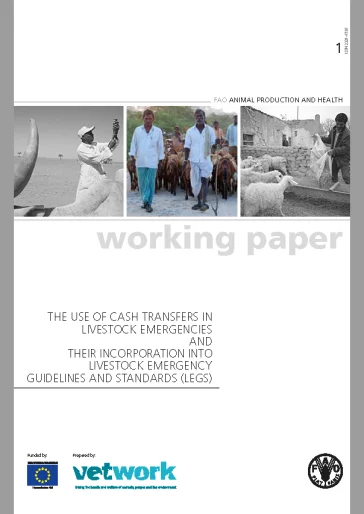
The Use of Cash Transfers in Livestock Emergencies and their Incorporation into Livestock Emergency Guidelines and Standards (LEGS)
Guidelines and Tools
This paper reviews the use of cash transfers within the livestock sector and suggests how they can be incorporated into and support Livestock Emergency Guidelines and Standards (LEGS). The paper’s structure reflects the stages of the LEGS Handbook as these in turn reflect good project cycle management....